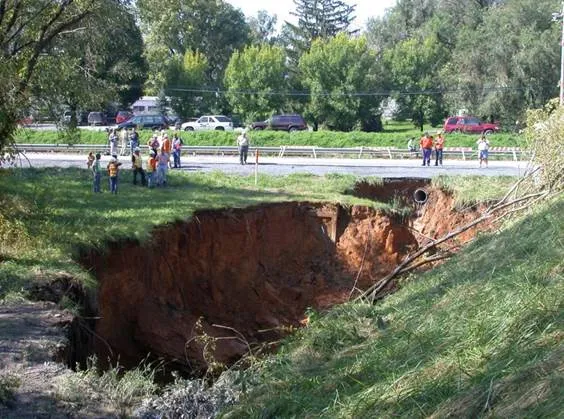
Sinkholes can be quite terrifying. We see them on the news, on television and in movies seemingly appearing out of nowhere, swallowing up cars and creating calamity in towns across the world.
In part one of the blog series, we discuss what a sinkhole is, three different types of sinkholes, and what causes them to form. In this second part, we explore how to detect sinkholes, what to do if you detect a sinkhole, and the steps taken to repair them.
WELCOME TO PART TWO: DON’T GET SUNK: EVERYTHING YOU NEED TO KNOW ABOUT SINKHOLES
HOW TO DETECT A SINKHOLE:
Not all sinkholes are Hollywood-style monstrosities capable of swallowing your whole house. But even a much smaller, less noticeable sinkhole can do its fair share of harm, compromising your foundation and damaging utilities.
Although sinkholes can be scary to think about, you can take comfort in knowing there are ways to detect them, both visually and experimentally. Often, you can spot the effects of a developing sinkhole before you can spot the hole itself. If you live in an area with characteristics common to sinkhole formation (i.e. “karst terrain,” or types of rocks that can easily be dissolved by groundwater), there are some things you can do to check your property for signs of potential sinkhole formation.
According to the American Society of Home Inspectors, there are key signs you should be on the lookout for in and around your home:
Inside:
· structural cracks in walls and floors;
· muddy or cloudy well water;
· interrupted plumbing or electrical service to a building or neighborhood due to damaged utility lines; and
· doors and windows that don’t close properly, which may be the result of movement of the building’s foundation.
Outside:
· previously buried items, such as foundations, fence posts, and trees becoming exposed as the ground sinks;
· localized subsidence or depression anywhere on the property; in other words, an area that has dropped down relative to the surrounding land;
· gullies and areas of bare soil, which are formed as soil is carried towards the sinkhole;
· a circular pattern of ground cracks around the sinking area;
· localized, gradual ground settling;
· formation of small ponds, as rainfall accumulates in new areas;
· slumping or falling trees or fence posts; and
· sudden ground openings or ground settlement, keeping in mind that sudden earth cracking should be interpreted as a very serious risk of sinkhole or earth collapse.
ACTIONS TO TAKE IF YOU BELIEVE YOU’VE DETECTED A SINKHOLE:
If you spot any of the signs listed above, or you suspect that you have a sinkhole on or near your property, you should contact your township, public works, or the local engineering firm that represents your municipality right away. If you have discovered a sinkhole that is threatening your house or another structure, be sure to get out immediately to avoid a potentially dangerous situation.
Also, it is highly recommended that:
· If a sinkhole expert can’t get to the area relatively quickly, you ensure that kids and animals keep away, fence/rope-off the area while maintaining a far distance away from the actual sinkhole, keeping in mind that doing so requires extreme caution and is always best left to the experts when possible;
· Notify your neighbors, local Water Management District, and HOA;
· Take photos to document the site;
· Remove trash and debris from around the suspected area in order; and
· Keep detailed records of all the actions you took.
If you’re trying to determine whether or not you have a sinkhole on your property, there are a few physical tests that can be conducted to determine the best course of action.
Electro-resistivity testing: This extremely technical test can best be summed up by saying it uses electrodes to determine the conductivity of the soil. Since electricity can’t pass through air, this test shows any pockets where the current didn’t pass through. This is a fairly accurate way to determine if there is a sinkhole and where it is.
Micro-gravity testing: Another incredibly technical method, this test uses sensors that detect the measure of gravity. Since the gravitational pull in a given area should be the same, you can see if there are minute differences in the measurement. If there is a difference, then it’s likely that you have a sinkhole in that area.
If you are still unsure whether or not you live in a sinkhole risk area, you can check with your local, territorial, or national government offices; review geological surveys such as the United States Geological Survey (USGS); and contact an expert.
HOW A SINKHOLE IS REPAIRED?
There are three main techniques experts utilize to repair sinkholes. The type of sinkhole and landowner’s aesthetic preferences determine the methodology used to repair the sinkhole.
The three common methods are:
1. Inject grout with a drill rig: This uses a piece of large drilling equipment that pierces the ground and goes down into the sinkhole, injecting it with grout/concrete. This method stops the filling of the carbonate crack with sediment since concrete and grout do not break down into such small particles (no piping).
2. Inverted cone: With this method, the construction crew digs down and finds the bowl-shaped opening. They then open up the surface so that the entire sinkhole area is exposed. To stop the draining of sediment into the crack in the carbonate rock, they fill the hole with bigger rocks first, then gradually fill in the seams with smaller rocks until the sinkhole is plugged.
3. Filling it with concrete/grout from the surface: This is a combination of the prior two methods. The construction crew opens the surface all the way up so the entire hole is exposed. Then, they bring in a big concrete pourer and fill the sinkhole with concrete.

Our engineers regularly go out in the field to oversee and inspect sinkhole repairs. If you detect a sinkhole, or what might be a sinkhole, on your property, our experts strongly advise immediate actions be taken. Ignoring a sinkhole will only cause it to get larger and more dangerous as time passes, and putting topsoil over a sinkhole will only exacerbate the symptoms.
WHAT CAN YOU DO TO PREPARE FOR A SINKHOLE?
While there’s really no way to prevent a sinkhole, you can never be too prepared! Here are three easy steps you can take to determine if you live in or around a sinkhole-prone area and what to do in the event of a surprise sinkhole:
1. Find out whether or not you’re living in one of the sinkhole-prone states, which includes Pennsylvania, Texas, Florida, Alabama, Tennessee, and Missouri. You can do so by visiting USGS.com and searching for Bedrock Geology maps of your area. If your town is underlain by carbonate rocks, you are likely in a sink-hole prone area.
2. Contact an engineer who’s certified to deal with sinkholes to determine if your property is at-risk.
3. Develop a plan for what to do in the event of a sinkhole. Do you grab your family, pets, and leave immediately? Do you have a safe zone somewhere near (but not too near) your property? Do you have the appropriate emergency contact numbers in your phone? Does your car have a safety kit? These are some of the things to consider when making your emergency plan.
4. Speak with your insurance company to see if they have sinkhole coverage, especially if you live in an area where they’re known to occur.
Although scary, sinkholes are a manageable threat if you’re informed and prepared. After all, it is possible to do something about sinkholes – if they can be detected in time.


